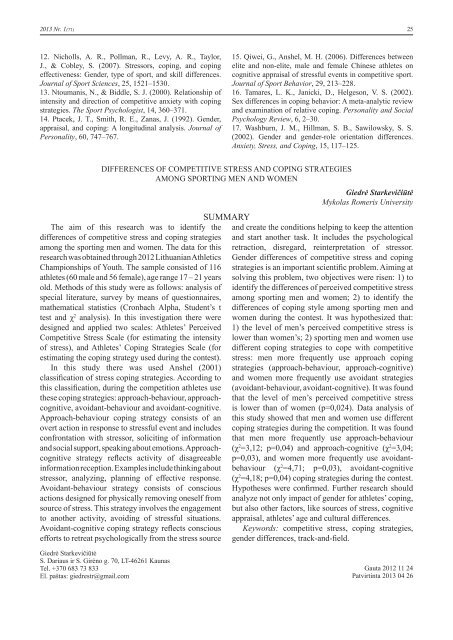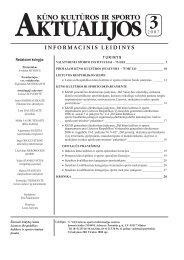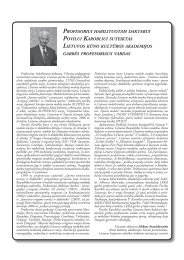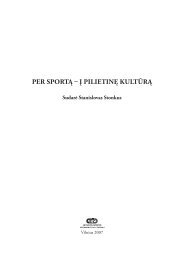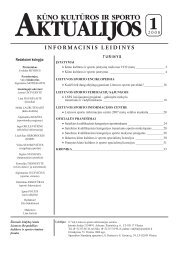Nr. 1 - Lietuvos sporto informacijos centras
Nr. 1 - Lietuvos sporto informacijos centras
Nr. 1 - Lietuvos sporto informacijos centras
Create successful ePaper yourself
Turn your PDF publications into a flip-book with our unique Google optimized e-Paper software.
2013 <strong>Nr</strong>. 1(71)<br />
25<br />
12. Nicholls, A. R., Pollman, R., Levy, A. R., Taylor,<br />
J., & Cobley, S. (2007). Stressors, coping, and coping<br />
effectiveness: Gender, type of sport, and skill differences.<br />
Journal of Sport Sciences, 25, 1521–1530.<br />
13. Ntoumanis, N., & Biddle, S. J. (2000). Relationship of<br />
intensity and direction of competitive anxiety with coping<br />
strategies. The Sport Psychologist, 14, 360–371.<br />
14. Ptacek, J. T., Smith, R. E., Zanas, J. (1992). Gender,<br />
appraisal, and coping: A longitudinal analysis. Journal of<br />
Personality, 60, 747–767.<br />
15. Qiwei, G., Anshel, M. H. (2006). Differences between<br />
elite and non-elite, male and female Chinese athletes on<br />
cognitive appraisal of stressful events in competitive sport.<br />
Journal of Sport Behavior, 29, 213–228.<br />
16. Tamares, L. K., Janicki, D., Helgeson, V. S. (2002).<br />
Sex differences in coping behavior: A meta-analytic review<br />
and examination of relative coping. Personality and Social<br />
Psychology Review, 6, 2–30.<br />
17. Washburn, J. M., Hillman, S. B., Sawilowsky, S. S.<br />
(2002). Gender and gender-role orientation differences.<br />
Anxiety, Stress, and Coping, 15, 117–125.<br />
DIFFERENCES OF COMPETITIVE STRESS AND COPING STRATEGIES<br />
AMONG SPORTING MEN AND WOMEN<br />
The aim of this research was to identify the<br />
differences of competitive stress and coping strategies<br />
among the sporting men and women. The data for this<br />
research was obtained through 2012 Lithuanian Athletics<br />
Championships of Youth. The sample consisted of 116<br />
athletes (60 male and 56 female), age range 17 – 21 years<br />
old. Methods of this study were as follows: analysis of<br />
special literature, survey by means of questionnaires,<br />
mathematical statistics (Cronbach Alpha, Student’s t<br />
test and χ 2 analysis). In this investigation there were<br />
designed and applied two scales: Athletes’ Perceived<br />
Competitive Stress Scale (for estimating the intensity<br />
of stress), and Athletes’ Coping Strategies Scale (for<br />
estimating the coping strategy used during the contest).<br />
In this study there was used Anshel (2001)<br />
classification of stress coping strategies. According to<br />
this classification, during the competition athletes use<br />
these coping strategies: approach-behaviour, approachcognitive,<br />
avoidant-behaviour and avoidant-cognitive.<br />
Approach-behaviour coping strategy consists of an<br />
overt action in response to stressful event and includes<br />
confrontation with stressor, soliciting of information<br />
and social support, speaking about emotions. Approachcognitive<br />
strategy reflects activity of disagreeable<br />
information reception. Examples include thinking about<br />
stressor, analyzing, planning of effective response.<br />
Avoidant-behaviour strategy consists of conscious<br />
actions designed for physically removing oneself from<br />
source of stress. This strategy involves the engagement<br />
to another activity, avoiding of stressful situations.<br />
Avoidant-cognitive coping strategy reflects conscious<br />
efforts to retreat psychologically from the stress source<br />
SUMMARY<br />
Giedrė Starkevičiūtė<br />
Mykolas Romeris University<br />
and create the conditions helping to keep the attention<br />
and start another task. It includes the psychological<br />
retraction, disregard, reinterpretation of stressor.<br />
Gender differences of competitive stress and coping<br />
strategies is an important scientific problem. Aiming at<br />
solving this problem, two objectives were risen: 1) to<br />
identify the differences of perceived competitive stress<br />
among sporting men and women; 2) to identify the<br />
differences of coping style among sporting men and<br />
women during the contest. It was hypothesized that:<br />
1) the level of men’s perceived competitive stress is<br />
lower than women’s; 2) sporting men and women use<br />
different coping strategies to cope with competitive<br />
stress: men more frequently use approach coping<br />
strategies (approach-behaviour, approach-cognitive)<br />
and women more frequently use avoidant strategies<br />
(avoidant-behaviour, avoidant-cognitive). It was found<br />
that the level of men’s perceived competitive stress<br />
is lower than of women (p=0,024). Data analysis of<br />
this study showed that men and women use different<br />
coping strategies during the competition. It was found<br />
that men more frequently use approach-behaviour<br />
(χ 2 =3,12; p=0,04) and approach-cognitive (χ 2 =3,04;<br />
p=0,03), and women more frequently use avoidantbehaviour<br />
(χ 2 =4,71; p=0,03), avoidant-cognitive<br />
(χ 2 =4,18; p=0,04) coping strategies during the contest.<br />
Hypotheses were confirmed. Further research should<br />
analyze not only impact of gender for athletes’ coping,<br />
but also other factors, like sources of stress, cognitive<br />
appraisal, athletes’ age and cultural differences.<br />
Keywords: competitive stress, coping strategies,<br />
gender differences, track-and-field.<br />
Giedrė Starkevičiūtė<br />
S. Dariaus ir S. Girėno g. 70, LT‐46261 Kaunas<br />
Tel. +370 683 73 833<br />
El. paštas: giedrestr@gmail.com<br />
Gauta 2012 11 24<br />
Patvirtinta 2013 04 26


